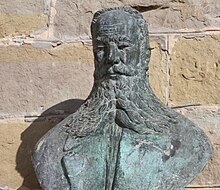Eugenio Geiringer
Eugenio Geiringer (born February 25, 1844 in Trieste ; † November 18, 1904 there ) was an Austrian engineer and architect who was particularly important for the city of Trieste. His neoclassical buildings show a style that was predominant at the time of the Austro-Hungarian Danube Monarchy.
Life
Eugenio Geiringer was born as the son of Ruben Isach Robert Geiringer, born in Gajary , and Eva Morpurgo, who came from an old Trieste banking family, which among other things was the founder of the Generali insurance company .
After primary and secondary school, Geiringer attended the Trade and Maritime Academy of Trieste (today's Istituto Nautico ), which was founded by the Austrian Empress Maria Theresia in 1774. He then studied mathematics in Padua , and in 1864 he became a graduate engineer.
At first he worked as a teacher for technical and industrial mechanical drawing at the public secondary school in Trieste and then, from 1872 to 1877, was a bank director at the Banca Triestina di Costruzioni and chairman of the Association of Engineers and Architects.
In 1874 he married Ortensia Luzzatti, with whom he had seven children. One of his sons, Pietro (1886–1944), who with his father was a member of the Board of Directors of the Generali insurance company , was murdered together with his wife Francesca Vivante in the Auschwitz concentration camp .
Geiringer was, among other things, a member of the Liberal National Party, a member of the city council and a member of the provincial parliament. In his hometown of Trieste he made a significant contribution to the construction of the “Tram von Opicina”, a tram that is still in operation in parts today and is equipped with a special mechanism with which the train can cope with the very steep route up to Opicina. Furthermore, he began work on the Trieste – Vienna railway line, which runs across the Austrian Hohe Tauern, and also participated in several projects to promote the railway network in Istria, Carinthia and Slovenia.
Eugenio Geiringer died in Trieste on November 18, 1904.
Buildings
According to the plans of the architect Giuseppe Bruni, Geiringer led the work on the construction of the town hall and the elegant Hotel Vanoli (today Hotel Duchi d'Aosta) on the Piazza Grande (today Piazza Unità) from 1872 to 1877 .
In 1883 Geiringer was commissioned by the Assicurazioni Generali insurance company to design a new head office in via Cavour. Between the two obelisks on the roof of the imposing building, the year the well-known insurance company was founded (1831) is still clearly visible today. A colonnade at the entrance of the building leads to a large hall with a spectacular flight of stairs.
The beautiful Villa Geiringer , which dominates the entire Bay of Trieste from the height of the Scorcola hill, was built in 1896 in place of an earlier building. During the invasion of Yugoslav troops at the end of the Second World War, the Castelletto ("Schlösschen") functioned as the seat of the Allied General Command. According to Monsignor Antonio Santin (1895–1981), at that time there was an underground passage through which one could get from the villa to the military hospital. Today the Villa Geiringer is the seat of the parified private school "European School of Trieste".
The Villa Fausta in Salita di Gretta 5, which was built in 1855 by Muzio Giuseppe Spirito de Tommasini (1794–1879), was enlarged by the engineer Eugenio Geiringer and then bought by Livia Fausta Veneziani, who for some time with her husband, the writer Italo Svevo (1861–1928), lived there.
The Castello Basevi , which resembles a medieval castle, is located in via Tiepolo 11 and initially belonged to Countess Diana. It was bought by Giuseppe Basevi in 1895 and badly damaged by an earthquake that same year. The building was enlarged by Eugenio Geiringer and leased to the Austro-Hungarian government in 1898, which set up the Central Institute for Meteorology and Geodynamics in it. Today the villa houses the National Institute of Astrophysics of Trieste.
The neoclassical building of the Banca d'Italia in via Cavour 141 was also built at the beginning of the 20th century by Eugenio Geiringer in collaboration with the Austro-Hungarian architect Müller.
Web links
| personal data | |
|---|---|
| SURNAME | Geiringer, Eugenio |
| BRIEF DESCRIPTION | Austrian engineer and architect |
| DATE OF BIRTH | February 25, 1844 |
| PLACE OF BIRTH | Trieste |
| DATE OF DEATH | November 18, 1904 |
| Place of death | Trieste |








